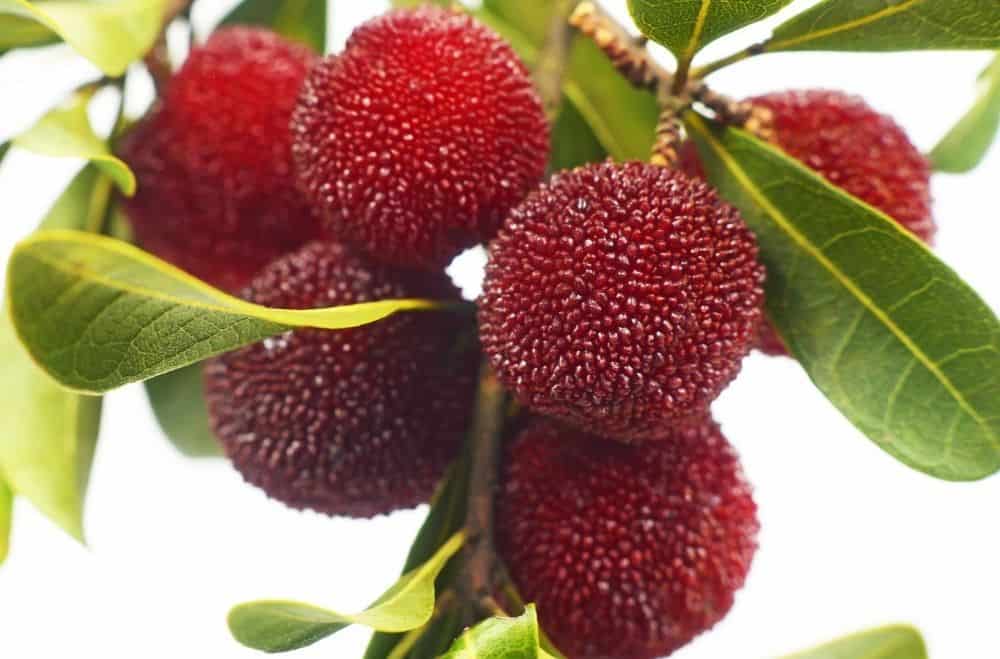
Have you ever wondered what a yumberry is? Yes, it’s a real fruit with a delightful taste and mouth-watering flavor. Keep reading to learn all about the yumberry fruit, including its unique flavor, health benefits, 10 fun facts, and more!
What is a yumberry?
The yumberry (also called the Japanese bayberry and Chinese bayberry) is a fruit commonly found in the northern parts of Asia, Japan, Korea, and China. It is also found in other parts of the world, including the United States.
What is a yumberry’s flavor like?
The yumberry has a very distinct appearance. It is a small, shiny, maroon-colored fruit shaped like a small grape. In fact, the fruit is so small that it can be eaten whole, and it has a unique flavor that is unlike any other fruit.
The flavor of this berry is not quite like a plum, pomegranate, raspberry, or any other fruit commonly found in the United States. The fruit is sweet but has a unique tartness that makes it different from any other fruit out there. And yes, it is super yummy, just as its name suggests.
These berries are a great fruit to eat raw, but they also work well in recipes. They can be used in baked goods, like cakes and pastries, and to flavor other foods like candies, jams, jellies, other desserts, frozen yogurt, ice cream, juice, and tea.
Health benefits of the yumberry
Yumberries contain riboflavin
Riboflavin, also known as vitamin B2, is a water-soluble vitamin that plays a crucial role in maintaining your overall health. Yumberries are a great source of riboflavin, which can help:
- Boost energy levels: Riboflavin helps convert food into energy, which can help you feel more alert and energized throughout the day.
- Promote healthy skin and eyes: Riboflavin is essential for maintaining healthy skin and eyes and can help prevent skin disorders and eye diseases.
- Support healthy growth and development: Riboflavin is important for healthy growth and development, especially in children and adolescents.
Yumberries contain thiamine
Thiamine, also known as vitamin B1, is another important water-soluble vitamin found in yumberries. Here are some ways thiamine can benefit your general health:
- Boost immune system function: Thiamine plays a key role in supporting your immune system, which can help protect you from illnesses and infections.
- Improve brain function: Thiamine is important for maintaining healthy brain function and can help improve memory, focus, and concentration.
- Support cardiovascular health: Thiamine is essential for maintaining a healthy heart and cardiovascular system and can help reduce the risk of heart disease and stroke.
10 Yumberry Fun Facts
Impress your friends with these ten fun facts about the yumberry.
1. They are pricy.
The yumberry is one of the most expensive fruits to purchase in Japan. This is because it is so difficult to cultivate and even more difficult to import.
2. You can take yumberry tours.
This fruit is so popular in Japan that special tours are dedicated to going on yumberry hunts. These events are seasonal and not offered very often.
3. They go by a lot of fun nicknames.
The yumberry is also called a Japanese mulberry in the United States. Other names you may hear include:
- myrica rubra
- yangmei
- yamamomo
- Chinese bayberry
- red bayberry
- waxberry
- Chinese strawberry
- monkey face fruit
4. It’s an ancient fruit.
The yumberry has been grown in China for over 2,000 years. The trees are beautiful and still grow along streets as natural decor.
5. Yumberry is a new name.
Yumberry is a relatively new moniker for this delicate fruit. In 2003, a garden products importer from Indiana named Charles Stenftenagel gave it the nickname yumberry to describe the flavor.
In this New York Times article, Stenftenagel shares that yang-mei in Chinese dialect is pronounced “yang-mee,” which sounds a little like “yummy,” so that’s where he got the idea to coin the fruit “yumberry.”
6. There are lots of different types.
There are over 100 types of yumberries that are grown all over the world. That’s why there are so many different names for it and why you might find it called different things depending on where it’s grown.
7. Yumberries are medicinal.
It has been used in traditional Chinese medicine for over 1,000 years. It was used as an astringent, antidote, and anti-diarrheal agent.
8. It looks like a monkey’s face.
They are also referred to as “monkey face fruit” in China because the fruit’s shape looks like a monkey’s face.
9. Yumberries have more vitamin C than oranges
The yumberry is a great source of vitamin C, which supports a healthy immune system and is also great at fighting the common cold and flu viruses. The fruit contains 13.6 milligrams of this powerhouse vitamin per cup.
10. Yumberry is used to treat ailments.
This superfruit has been used to treat cholera, heart ailments, and stomach diseases.
FAQs
How do you eat yumberries?
Most people eat this fruit fresh, just like raspberries or strawberries, and you might also find yumberries canned, dried, or pickled. These red berries are often made into juice or wine.
Where can I find yumberries?
You can find fresh yumberries (and yumberry-flavored products) at farmer’s markets, Asian markets, and grocery stores like Whole Foods. You will most likely find yumberry drinks or juices in America.
How many yumberries are grown in China?
Since yumberries are so popular in China, twice as many acres of land are devoted to growing them as the number devoted to apple orchards in the U.S.

